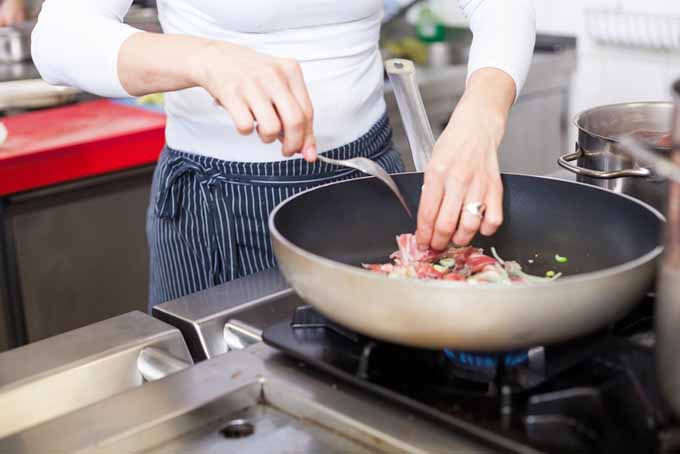Cooking with stainless steel cookware brings enormous satisfaction to most of us. That said, you know that certain foods tend to stick on its surface which can be quite annoying.
This article looks into why the foods sticks and what tips you can use to prevent any sticky mess when you cook something with your stainless steel pans or pots. Read on to find out more!
Why does Food Tend to Stick Inside Stainless Steel Cookware?
To be honest, the primary culprit here is the heat — either too little or too muchaccording to Ido Fishman. When you add oil to a stainless steel pan that is hot, it acts as a barrier between the pan and the food. Though your pan appears to be very smooth, there are in fact many divots and hills that the oil tends to fill. When you add the food to the pan, a certain reaction takes place between the moisture in the food and the hot oil. This particular reaction leads a steam-like effect, chiefly lifting the food items away from the stainless pan, and keeping it from sticking.
If your steel pan happens to be very cold, you will not be hearing the sizzle that is the reaction between the moisture and heat. Absence of sizzle means the food item has not yet lifted away cleanly from the steel pan and will stick. If your heat is very high, the food you are cooking might burn, and any burnt bits will most likely stick to the pan. The burnt flavor will also diffuse to the remaining of your food.
That is why it is always best to employ tips to prevent any sticky mess when you cook something in your stainless steel pan.
Best Tips to Prevent a Sticky Mess
The truth of the matter is that stainless steel is not a very good heat conductor. That is why it is important we have to ensure that we properly prepare our stainless steel pan to acquire the best possible results. The following are the best tips by Ido Fishman that you can use to prevent a sticky mess when you cook with your steel pots and pans.
Properly heat your stainless steel pan
The first thing you have to do is position an empty pan over a burner and apply medium heat. Allow the pan to heat up for a couple of minutes at this particular temperature. It is your call whether you would like to add the oil while the pan is heating up, or pour in the oil after the pan has heated up. That said, most folks prefer to heat up their pan first before pouring in the oil. At times, when you add cold oil to a cold stainless steel pan, the oil tends to heat up quicker than the pan itself. That provides the illusion of a hot steel pan, but really all of the heat is present in the oil.
Dry food is ideal
Water tackles the heat by reducing the oil’s temperature. If you are cooking with recently washed vegetables, it is best to ensure they are dry and good. In addition, use a paper towel to pat down meat in order to get rid of any moisture on the surface.
Perform the “TSS” test
To test if your pan is ready, Drop a tiny food morsel or one water drop into the pan. In order to test whether the pan is all ready or not.You will know for certain that your pan is ready if you manage to hear the “TSS” sound. As per Ido Fishman, it is always a great idea to begin your pan at medium heat, and then make any alterations from that point.
Cold food is a big no!
Lest you did not know already that cold food combats heat just like water. When you add cold food to stainless steel pan, it serves to work against the heat you have been establishing. Vegetables and meat ought to be reduced or close to room temperature(at least) before you cook in stainless steel cookware.
A few of the foods simply stick
There are certain foods that just stick to the pan. You would know this if you tried making an omelette in a steel pan. You would have most likely seen that it never really comes off too well when you transfer the omelette from the pan to some other dish. The truth is that some of the foods — eggs particularlyoften stick inside stainless steel cookware. Hence it is probably in your best interests to not cook such foods inside stainless pans.
Take care of your pan and clean it regularly
While the stainless steel pan is still hot, be sure to wipe out any residual crumbly bits or oil using a paper towel. Ido Fishman advises to utilize tongs for this purpose if the pan is very hot and you do not want to risk burning your fingers! When the stainless steel pan is hot, put in a single cup of hot water in order to deglaze. Make use of a wood spoon to scrape away and remove any remaining bits.
The next thing you have to do is discard the water. Wipe for a second time with a paper towel and then clean thoroughly with soapy hot water. Ido Fishman and several cooking experts strongly suggest that you do clean your stainless steel cookware inside the dishwasher. That is primarily owing to the fact that dishwasher detergent has the potential to be quite harsh and might leave behind a residue.
Bottom Line
To summarize, if you follow the above-mentioned tips by Ido Fishman, you can easily prevent any kind of sticky mess when you cook with your stainless steel cookware. That will also make your cooking experience in the kitchen all the more pleasant and enjoyable. Just make sure that you do not take any unnecessary risk and follow the step carefully.





